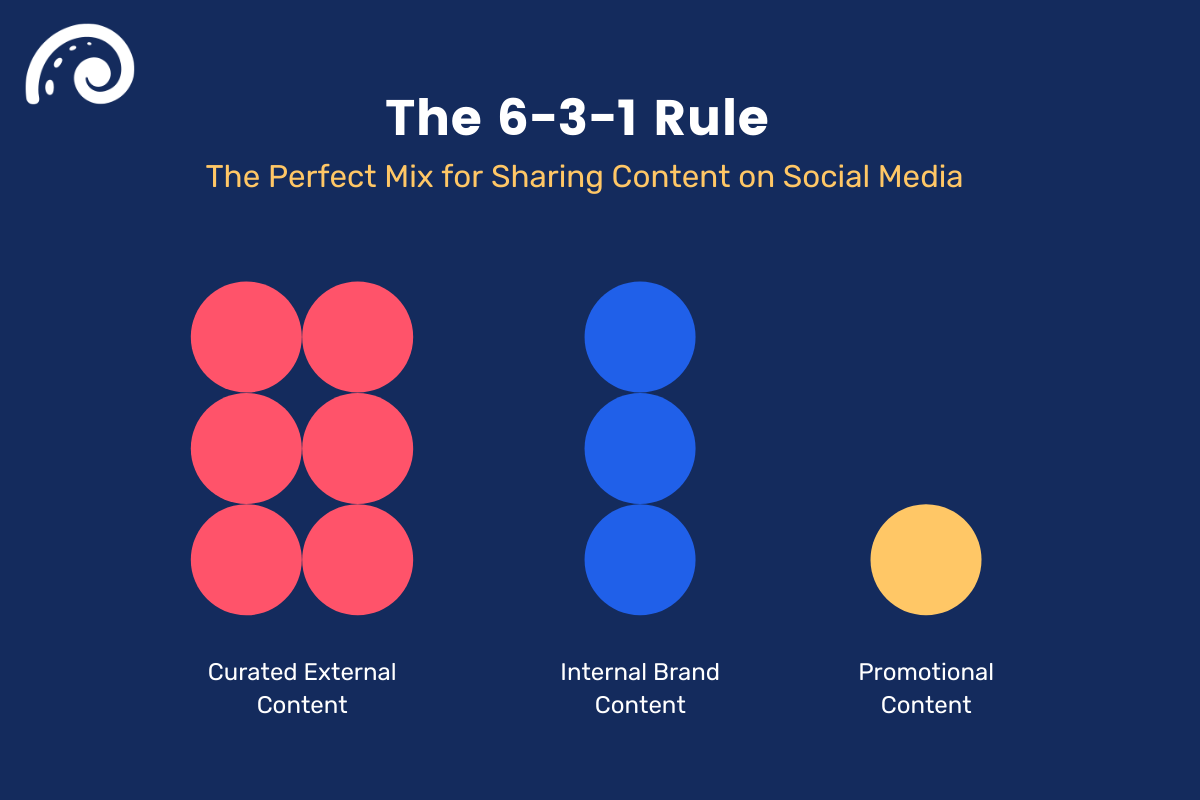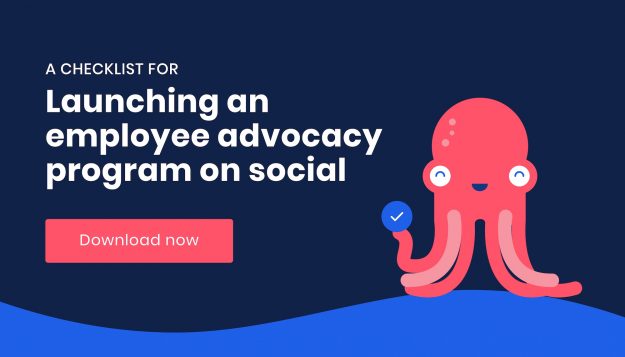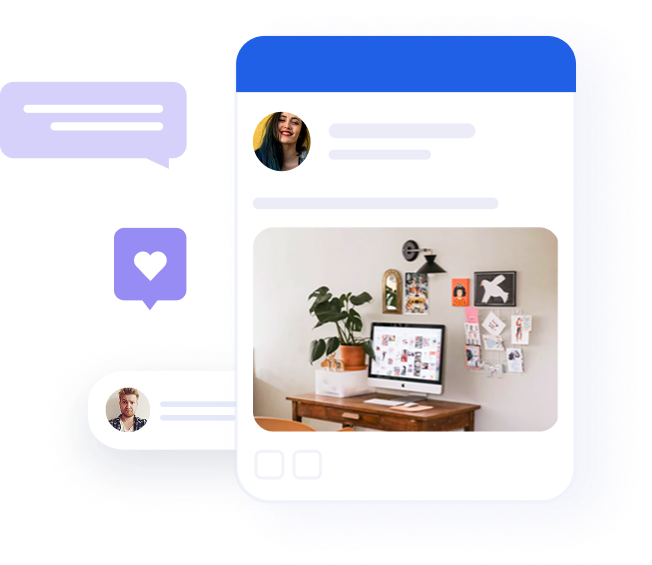
B2B employee advocacy: a strategic guide to implementation and success
Table of contents
- What is employee advocacy?
- Why employee advocacy matters for B2B
- 9 Benefits of employee advocacy
- How to launch an employee advocacy program in 6 steps
- 5 Ways to drive employee advocacy adoption
- How to measure and maximize B2B employee advocacy ROI
- How to choose the right platform for employee advocacy
- Key employee advocacy takeaways
People don’t buy from brands – they buy from people. And that goes double with B2B.
B2B Employee advocacy is the key to getting your employees to spread your brand message in their unique voices. It’s no surprise that nearly half of CMOs polled last year stated that employee advocacy was their best-performing initiative (even earning more ROI over paid ads).
With brands using employee advocacy earning 25%-40% more overall engagement over brands that don’t, it’s easy to see why.
But figuring out just how to get employees to share brand content and speak positively about the company on social media can be a challenge. In this piece, we’ll go over what employee advocacy is, how your brand and employees can benefit, and how to launch your own program successfully.
In fact, we applied the advice in this post to ourselves, and earned 266% more conversions from social in just 90 days!
Table of contents
- What is Employee Advocacy
- Why Employee Advocacy Matters for B2B
- 9 Benefits of Employee Advocacy
- How to Launch an Employee Advocacy Program in 6 Steps
- 5 Ways to Drive Employee Advocacy Adoption
- How to Maximize Employee Advocacy ROI
- How to Choose the Right Platform for Employee Advocacy
What is employee advocacy?
Employee advocacy is the promotion of a company by its employees. By sharing company-related content to their personal social media profiles, employees amplify a company’s message.
Employee advocacy is not merely resharing corporate posts, it goes much further than that to be effective. B2B Employee advocacy is most powerful when it comes from your employees’ points of view.
Employee advocacy is at its best when:
- Employees post and share authentically
- It feels informal, and unique
- It’s in your employees’ unique voices and posting styles
It can take months for a B2B marketing team to build up a company’s presence and credibility online. And your own corporate accounts on LinkedIn, Twitter, Facebook and Instagram may not be able to do all the heavy lifting alone.
Every post shared by employees reaches hundreds of new connections: on average, employees have 10 times more followers than corporate pages.
The opportunity to engage a wider audience is unparalleled, and of course, can be immensely helpful to a brand. It’s the responsibility of a company’s leadership to create a culture that employees will want to favorably post about. Aside from a positive workplace experience, any company looking to join the employee advocacy bandwagon must offer a team-wide, sustainable support system.
Why employee advocacy matters for B2B
Many B2B organizations believe that the future of social media marketing lies in B2B employee advocacy. When we published The State of B2B Social Media Marketing Report, we found that on average, nearly half of CMOs said that employee advocacy was their best performing social media initiative.
Going further, another 32% said that their second-most performant social initiative was social selling—a close cousin to employee advocacy.

B2B Employee advocacy goes further than just benefiting a brand – it’s also great for building your employees’ personal brands. In fact, according to Hinge Research Institute, 86% of employees participating in employee advocacy programs say it benefited their careers.
Learn more employee advocacy statistics for B2B!
Recommended for further reading
9 Benefits of employee advocacy
By tapping into the power of your own employees, you can significantly increase your company’s social media reach, without exceeding your budget. A wider reach means more opportunity to engage your audiences and eventually generate leads from social media through organic content.
Let’s zoom in on a few benefits of B2B employee advocacy:
- Brand Amplification: Social networks tend to prioritize meaningful interactions between people over branded content. So how do you get your message across? Your employees each have individual, personal networks with former colleagues and other like-minded professionals.
- Build Trust: B2B customers are people, and people buy from people—not brands. Employee advocacy infuses an element of personality and individual experience into your marketing strategy.
- Social Selling: Your sales team can be your best employee advocates. No one understands or relates to prospects and customers better than they do. Sharing content on social media is a powerful tool that can help close more opportunities and draw in prospects.
- Employer Branding: The real star of your employer branding strategy is your team, so step back and let them take the lead once you’ve communicated your goals and expectations. The more your employees tailor your recruitment marketing content to their audiences, the more authentic and relatable their outreach will be.
- Employee Engagement: When employees become brand ambassadors, they feel a vested interest in the company’s success. Employees who serve as advocates are more engaged at work, and engaged employees are more likely to become better advocates—a virtuous cycle.
And those benefits don’t even start to cover the benefits of employee advocacy for employees:
- Thought Leadership: Employee advocacy oftentimes leads to building a great personal brand for employees. Sharing content with value-adding commentary can help transform an employee into a thought leader.
- Better Networking: When employees are regularly sharing content relevant to their fields, they’re opening up topics for discussion. These conversations are a great way to build their networks with other like-minded professionals.
- Easy Sharing & Promotion: Many employees want to share company content, but it’s often difficult to know what to promote and when. An employee advocacy program can help define that.
- Generates Sales: For members of your sales and marketing teams, employee advocacy can be a great way to improve their own results. Every employee wants to perform better at their jobs.
How to launch an employee advocacy program in 6 steps
By now, you’re probably convinced that launching an employee advocacy program is one of the most cost-effective and ROI-positive things you can do for your B2B social media marketing.
Getting started with advocacy may seem difficult, but it doesn’t have to be. By planning ahead, you will be able to launch a successful employee advocacy program in these six steps:
Step 1. Outline a content strategy
Establishing a strategy is the single most important component of an B2B employee advocacy program. Without a clear plan, you won’t be able to communicate the value to employees and executives.
Start by defining what content you want employees to share. It should align with your corporate content strategy and match your advocates’ interests.
According to Andrew Davies, Head of Global Digital Marketing at Capco, an effective approach to content strategy is the Three E’s. Your content has to:
- Entertain
- Enlighten
- Educate
And if possible—all three.
Ask yourself: would you share this content to your personal profile? If the answer is no, then there’s no reason why your employees would.
Strive for the 6-3-1 rule: for every 10 pieces of content you provide to employees, 6 should be curated, 3 should be owned and 1 should be promotional.

Once you’ve determined your strategy, engagement data will help you measure how well your content is doing. If employees aren’t sharing specific types of content, move away from it and seek more engaging topics and formats.
Instead of using employee advocacy as yet another channel for echoing your corporate voice, be mindful of the self-promotional tone by making room for employees to celebrate the excitement with you.
Listen to your advocates! Post content they are interested in sharing, from sources they trust. And when dealing with branded content, make sure it aligns with the company’s agreed-upon voice and best practices, so advocates feel comfortable pushing it to their individual networks.” — Dan Hanna, Marketing Manager at Civis Analytics
Another best practice is segmenting advocacy content by topics. An HR manager and a web developer have different interests and will want to share different content. By segmenting your content by topics, you will make it easier for them to discover the content that’s most compelling for them and their networks.
Check out one of our employee advocacy templates if you’re stuck.
Step 2. Gain leadership and employee buy-in
Your C-level executives may not be immediately sold on employee advocacy—you need to show them how employee advocacy will impact the bottom line. Present examples of how employee advocacy works for other B2B organizations to show that employee advocacy can have a meaningful impact on business objectives.
Equally important is to demonstrate the value to employees. The success of your program will depend largely on employee buy-in. They should have a solid understanding of why the company encourages it and, above all, what’s in it for them.
Advocacy has the potential to turn employees into thought leaders, expanding their professional networks and helping develop their personal brand. Eventually, the accumulative effect of advocacy means significant career growth.
Step 3. Choose initial advocates
When companies scramble to implement an B2B employee advocacy program, the initial goal is often to onboard the entire company. After all, it’s in their best interests to have as many team members sharing content in order to get maximum reach and engagement.
While it’s great to be ambitious, having a “100% engaged or nothing” approach elicits unrealistic expectations. It’s important to carefully pick team members who will spearhead the advocacy program—and determine its success.
To hit the ground running, start a pilot focusing on your social enthusiasts, the employees who have an active presence on social media.
Usually, social enthusiasts are employees in customer-facing roles: marketing, sales, customer success. Not only will they be easier to onboard, but they are also your best bet for demonstrating success from the get-go.
A good place to start is by identifying a small group of influencers within your organization who already actively share company content and represent your company’s best interests. Make sure they get the best possible experience. They will soon spread the word to others in your company.” — Ryan Ofek, Digital Marketing Manager at NICE
The C-level executives are also a key group to onboard to advocacy. Leading by example is the concept you want to tap into by engaging your senior management. Once they start sharing content on social media, other employees will follow.
The majority of your employees probably feel optimistic about content sharing, but won’t go the extra mile toward being creative or original in their posts. And then you have your social curmudgeons who demonstrate the least amount of motivation for participating.
Once your pilot is in full swing, you’ll be able to get buy-in from the social majority, who will ultimately set a positive example for less social-savvy employees.
Step 4. Conduct social media training
Some of your employees are going to be new to social media, or at-minimum, perhaps not using best practices. These team members will require more guidance to boost up their confidence.
From newbies to pros, you will want to align everyone’s skills to ensure they’re starting off on the same page. Investing in proper training will lead to higher employee retention and engagement. It will also enable you to grow a fruitful advocacy program that drives a positive ROI.
In the beginning, we got a lot of “I’m not really on social media” or “I don’t feel comfortable promoting business content”. So we decided to hold a series of social media workshops for our employees. We covered the benefits of being active on social and what you need to pay attention to: tips and tricks, dos and don’ts.” — Rachel Young, Marketing Manager at Xylos
Your social media training should cover:
- A tour of the company’s social networks: Give an overview of your social media goals, target audience, competitors, content tactics, custom hashtags, etc.
- Review of company social media policy: A social media policy is a set of guidelines that clearly defines how employees should and shouldn’t use social media. If you don’t have one, check out our free social media policy template.
- Tips for building a top-notch profile: Uploading professional profile images and covers, crafting a compelling ‘about me’ section, connecting with users, engaging with the professional community and more.
- Onboarding & training: Introduce the team to your employee advocacy platform and walk them through the technical aspects of the program.
Here you can find a more in-depth employee advocacy training guide.
The more knowledgeable employees are about social media and sharing advocacy content, the more comfortable they will be to post. On the flip side, this knowledge will also benefit the company and help protect brand reputation.
Step 5. Run a pilot
An B2B employee advocacy pilot is an effective way to test out your team’s social media acumen, see what strikes a chord with your audience and what falls flat. It will also help demonstrate quantifiable results of employee advocacy and eventually gain support for your program’s budget and resources.
Here are some Oktopost pro-tips for a successful employee advocacy pilot run:
- Define the KPIs you want to measure: sharing, engagement, participation rate, ROI, etc.
- Let the pilot run for at least a month before measuring results. Hold weekly feedback sessions to identify opportunities and encourage great sharing.
- Encourage employees to give feedback: collecting and acting on feedback can solidify employee buy-in for advocacy.
- Demonstrate positive results: great results from your pilot will set the bar for employee advocacy implementation company-wide.
- Tweak as you go: The pilot serves to iron out the kinks of your employee advocacy program.
Once your pilot brings positive results, you are ready to launch a full-fledged employee advocacy program and gradually invite more advocates.
Step 6: Establish employee advocacy goals and KPIs
Defining what you want to achieve with advocacy will allow you to identify your tactics and measure your success. The good news is, if you already have a solid social media strategy, all you need to do is align your employee advocacy program with it.
Once your SMART (specific, measurable, attainable, realistic and time bound) advocacy goals are clear to you, you need to establish the right KPIs to track those goals.
Usually, B2B marketers choose to focus on these goals and metrics:
- Brand Awareness → Reach: If this is one of your goals, the first metric you should focus on is reach—to quantify how many people viewed your content. The more eyes you have on your content, the more recognizable your company becomes.
- Content Engagement → Likes, Shares, Clicks, and Comments: Try breaking engagement down by network to see which one is the most successful in terms of employee advocacy. You can also zoom in on specific posts that are generating the most engagement.
- Lead Generation → Leads: At the end of the day, B2B marketers need to generate leads. You should track the number of conversions garnered by posts that employees are sharing. Measuring the program’s true ROI will help you understand how advocates affect revenue metrics such as leads and closed deals.
- Employee Participation→ Platform sessions, Sharing rates, and Content shares: Monitoring metrics such as platform sessions, sharing rates and content shares will provide insights into internal employee engagement. If you want to create a long-lasting advocacy program that stems from trust and motivation, be transparent about great results.
5 Ways to drive employee advocacy adoption
As good as the statistics may sound, B2B employee advocacy is not a project you launch, sit back and watch the leads roll in. It’s an ongoing initiative that requires keeping employees engaged and entertained.
Train your employees well and don’t forget to remind them to post. They are often excited to help but can get caught up in their day to day work and forget to post. A simple reminder typically does the trick.” — Erika Childers, Content Marketing Coordinator at UserIQ
Here are a few different ways to optimize your employee advocacy program for maximum participation:
- Incentivize with a bit of R&R (rewards and recognition): Incentives go a long way toward increasing employee morale. That said, rewards shouldn’t come at the expense of recognition.
- Gamify the program to make it interesting: Turning anything into a game is a powerful way to transform ordinary tasks to receive extraordinary results. Even simple leaderboards can help get employees excited about advocacy and motivate them to become top advocates.
- Simplify content sharing: Your employee advocacy software can make or break your program. Ease of use is a major factor when it comes to the adoption of new technology.
- Be transparent about data: Let your advocates see how they’re impacting various metrics.
- Let employees suggest advocacy posts: Employees know their audience best, so it’s only natural to have them to suggest content for the advocacy board.You don’t have to approve every single one of their suggestions, however, seeing some of it on the board will give them a sense of partnership in the program.
Employees are your most valuable partners when it comes to ensuring the success of your advocacy program. Making them feel recognized, incentivizing them through tangible rewards and highlighting the personal benefits of advocacy—these are all effective ways to encourage employees to share your content and make your program a success.
Show your employee the real numbers they’re generating so they have a better understanding of how their efforts are impacting the company’s results. This level of transparency will make them feel valued and more motivated in the long-term.” — Shadi Kassis, Marketing Specialist at Munters
How to measure and maximize B2B employee advocacy ROI
As with any marketing strategy out there, building a smart B2B employee advocacy program involves gathering data and adjusting your strategy based on insights. With the right analytics, you’ll be able to see how employee advocacy contributes to your overall B2B marketing objectives and how your program drives website traffic, conversions and sales.
We shared the exact message from our paid ads into our advocacy board. While paid traffic converted site visitors to career searches at 3.93 percent, traffic driven by our advocates converted visitors at 51.7 percent. This one piece of data really drives home the importance of advocacy.” — Andrew Davies, Head of Global Digital Marketing at Capco
By having specific conversion points in mind, you can track which employee advocate activities are best helping to achieve them. For example, an employee’s tweet linking to your latest white paper might produce a spike in downloads, or a single LinkedIn message about an upcoming webinar might lead to more registrations.
If you find your advocacy reliably drives metrics such as engagement and sentiment but isn’t producing enough conversions, there are a few courses of action to take:
- Revisit your lead-nurturing content strategy: Ask a few questions about how well employee-shared content matches its intended targets. Is your content truly targeted to the kinds of leads employees encounter on social?
- Make sure employee advocate segments are well-matched with content: Look at the segments you defined in the beginning and determine whether the content is truly congruent with employees’ company roles.
- Define best-performing segments periodically: See which groups produce the most conversions. You might find, for example, that employees with a certain personal style of interaction or certain levels of social activity turn in more conversions than others.
Finally, revenue will always be the main determinant for program success. For an accurate understanding of how employee advocacy impacts your revenue, you’ll need to ensure a fully-integrated marketing technology stack. Connecting your employee advocacy data with marketing automation and CRM platforms can give you a more complete picture of how employee-generated leads impact revenue.
“Employee advocacy has become one of the top sources of our website traffic. Links that our advocates share via Oktopost account for almost half of all clicks from social media: over the past 2.5 years, advocacy went from generating around 15% of our social clicks to 45%.” — Rachel Young, Marketing Manager at Xylos
How to choose the right platform for employee advocacy
The right B2B employee advocacy platform should be tailored to your needs and goals, so it can help you improve the process of distributing and sharing content as well as analyzing results.
“Employees already have a lot of tasks on their plate. That’s why a successful program starts with an easy-to-use platform that makes it extremely simple and quick for employees to discover, filter, and share content anywhere they go.” — Daniel Klaus, Senior Manager Digital Marketing at Fujitsu
Here are the key features that B2B companies need to look for when choosing their employee advocacy tool:
- One-click sharing: The whole point of employee advocacy is to make it as simple as possible. The easier it is to share, the more likely employees are to take part in your advocacy program.
- Seamless Integration with your social media management platform: Your employee advocacy tool should be seamlessly connected with your social media management platform—even better if it’s an all-in-one tool. Integrated workflows allow you to manage advocacy programs without adding more work to your social media manager’s routine.
- Comprehensive Analytics:You can’t improve what you don’t measure. Like any other marketing strategy, employee advocacy must be monitored and measured. This data should be automatically synced with other social media analytics already being generated by your marketing team.
- Data Portability: Marketing and sales activities must be on the same page—and it’s no different when it comes to employee advocacy. Adding employee advocacy engagement data to your marketing automation and CRM platforms can help better score, nurture and attribute leads.
- Mobile App: Whether they prefer to share posts during a morning commute, lunchtime or on the way home, a dedicated mobile app is key to making this convenient and driving adoption.
Key employee advocacy takeaways
Employee advocacy is the new generation of B2B marketing that allows companies to amplify their reach, humanize their voice and drive meaningful business results. It has the power to reach thousands of fresh audiences and engage them with a personalized experience using nothing more than organic content.
But developing, launching and optimizing an employee advocacy program won’t happen overnight. There is a fair amount of work involved, plus you really need to play the long-term game here. Employee advocacy is rooted in authenticity and trust, which take time to develop.
With the right team, policies and technology, your organization will be on the leading edge of building social proof via employee advocates. If you’re ready to get started with advocacy and leverage your employees’ untapped reach, see how Oktopost can help.





